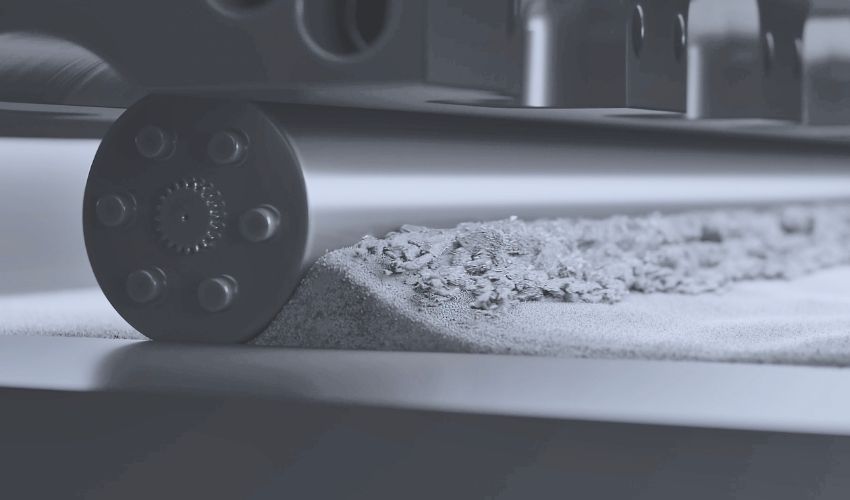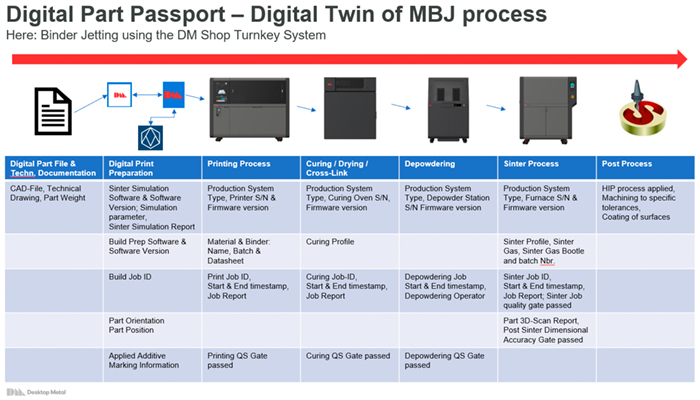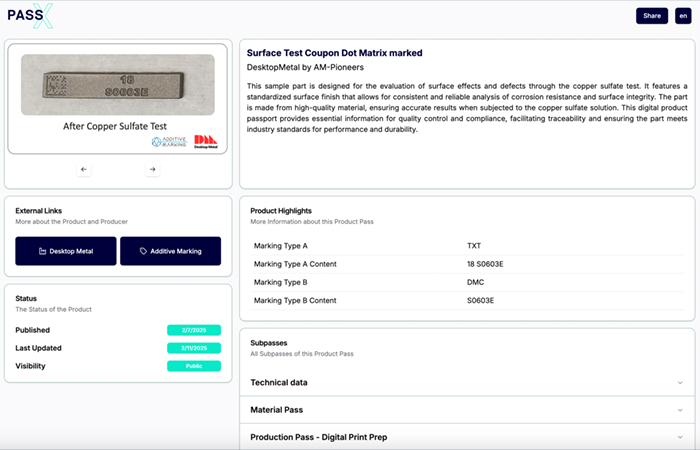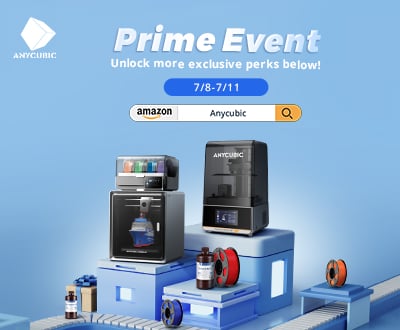How to Enhance Traceability in Additive Manufacturing by Integrating Digital Product Passports

One of the biggest benefits of digital manufacturing is the ability to more easily trace parts throughout their lifetime. Product traceability is critical when it comes to quality control, regulatory compliance and supply chain transparency. However, it can be hard for users to know how to take advantage of this and have a truly secure and verifiable record of a part’s lifecycle. That is why we sat down with Henrik Peiss and Dr. Ulrich Jahnke to talk about how digital product passports can be integrated into Desktop Metal’s additive manufacturing technology, binder jetting, for real-time tracking data. We discuss how this approach enhances authenticity, streamline certification processes, and paves the way for widespread industry adoption.
3DN: Could you tell us about yourself?
HP: I am Henrik Peiss, I have been working for Desktop Metal – based in Germany – since 2021 as the EMEA Application Team Lead and Sales & Technical Manager for DACH & Eastern Europe region. I have a mechanical engineering background and have worked the last 13 years worldwide in multiple roles in the additive manufacturing industry.

Dr. Ulrich Jahnke (left) and Henrik Peiss (right)
UJ: My name is Dr. Ulrich Jahnke. I have over 15 years of experience in 3D printing and the entire additive manufacturing process chain, allowing me to cultivate a deep expertise in this dynamic field. My academic journey began with a degree in engineering informatics, followed by research activities at Paderborn University, specifically within the Direct Manufacturing Research Center (DMRC).
In 2018, I co-founded Additive Marking with two partners, driven by the vision of implementing traceability directly in 3D-printed components. This initiative aims to actualize the principles of Industry 4.0 at the shop floor level. Our innovative technology bridges the digital and physical realms by assigning digital identities to tangible assets produced additively as well as conventionally.
Since 2020, I have been passionately dedicated to realizing the vision of Additive Marking, striving for comprehensive end-to-end traceability not only within additive manufacturing but across the broader industrial landscape. Nowadays our service and product portfolio also includes automation of laser marking, dot peening, and labeling processes as well as management of digital product passports by our Additive Marking Suite. Of course, we don’t just provide hard- and software for marking and scanning, we also provide solutions that means a methodical mixture of training and consulting is mandatory part of it.
3DN: What is the importance of product traceability in additive manufacturing?
HP: Additive manufacturing (AM) is a batch-based process, so, for example, for a single build job in binder jetting, we are dealing with a specific lot of powder and binder liquid plus corresponding surrounding conditions and machine wear status. To ensure traceability for quality control, it is important to be able to track down a part into a specific build job and even down to a specific part location within this build.
This is especially important when producing parts for industries like aerospace, defense or medicine technology. The quality standards in these branches require quality checks and documentation for each single part. AM as a digital manufacturing technology offers unique possibilities for automatic unique part marking during the process of digital print preparation.
UJ: I agree with Henrik. Product traceability in additive manufacturing (AM) plays a vital role in ensuring quality control, operational efficiency, and regulatory compliance. One of the key benefits of traceability is that it allows manufacturers to track each part throughout its entire production chain and even whole lifecycle – spanning data preparation, production, post-processing, and quality assurance followed by logistics, usage phase up to recycling. This comprehensive tracking is especially important in AM, as the material properties and dimensional accuracy of a component are determined during the manufacturing process.
Even parameters that seem to be less relevant like build orientation and positioning within the build volume can influence these properties. This is why it is so necessary to achieve traceability from the very first moment of a part’s production. And this is precisely the strength and unique advantage of additive marking: it allows for direct part identification during production without the need for additional labeling processes.
Unlike traditional manufacturing, where labeling can introduce risks of mix-ups or errors, the Additive Marking Suite machine readable identification can be directly embedded into the part during the digital and physical build process. This reduces the potential for mistakes and ensures the component is traceable efficiently.

Surface test coupon integrating an Additive Marking dot matrix code which links to the digital pass-x product passport of the part (top). Different sized Additive Marking generated QR-codes on another MBJ part (bottom)
Traceability is particularly critical in industries where safety and regulatory compliance are non-negotiable. It allows manufacturers to quickly identify and address any defects or deviations, enabling efficient recalls or replacements when necessary.
Moreover, traceability strengthens the integrity of the supply chain, supports the efficient management of digital inventories, and facilitates spare parts tracking. By scanning an embedded code on a part e.g. with our DPM Scan Pro Scan Engine available for iOS, Android as well as for stationary integration using industrial camera equipment, manufacturers can instantly access associated files in a digital warehouse, streamlining part identification and reducing downtime.
3DN: Could you tell us about digital passports and how they work?
UJ: Digital passports are a revolutionary concept in the realm of product traceability, particularly in additive manufacturing. A digital passport serves as a comprehensive digital record for each component, encapsulating essential information such as material specifications, manufacturing processes and processing parameters, quality control data, part individual maintenance history etc. This information is stored in a secure digital format and can be accessed throughout the product’s lifecycle with the code embedded in the component, product or machine.
By consolidating all relevant product data into a single, accessible platform like pass-x.eu, digital product passports empower manufacturers to enhance product quality, customer satisfaction, and overall operational efficiency. On pass-x.eu interoperability to parallel hosted platforms is given due to common standards! Some notable benefits include:
- Ensuring compliance and regulatory adherence e.g. Ecodesign for Sustainable Products Regulation, General Product Safety Regulation, Battery Regulation etc.
- Offering full traceability and transparency throughout the product lifecycle and use lifecycle information in next level development
- Supporting sustainability and the circular economy by aiding in recycling and reusing
- Building customer confidence through transparency and even provide cross selling opportunities
- Optimizing spare parts management and lifecycle tracking
HP: The digital part passports can be summarized as an implementation of the digital twin concept and acts as the central point of data storage/linking for all digital information around a unique specific part.

MBJ Process-Chart plus corresponding process step data which have been incorporated into a part’s digital part passport
From a user perspective a digital part passport as implemented by Additive Marking is the logical second step following the traceability of parts based on unique serial markings on the parts. The passport enables easy access and storage of unique information relating to a specific part and is digitally accessible via a unique machine-readable marking on a specific part. It is possible to set up specific sections of the passport, some are only visible to the manufacturer, others are accessible for all users.
With it, a user can access quality reports of a part, production data, corresponding material data sheets, user manuals or part maintenance schemes. When a Web-Shop link is also integrated into the digital passport, a user can re-order the part or corresponding supplies directly.
3DN: What benefits does it bring specifically when we are speaking about binder jetting?
HP: Binder jetting as an additive manufacturing 2.0 technology is focused on serial production of hundreds or even more parts. The importance of tracking down individual parts increases when supplying into the industries mentioned above. Besides the usage in these fields, traceability of parts helps a lot during the daily process of running a digital additive manufacturing production center: passed production steps, and production internal QA-Check-Gates can easily be done and documented by using the machine-readable codes on the parts.
A general advantage of binder jetting in combination with digital part marking is the fact that binder jetting enables smaller part markings based on the shrinkage during the sintering process. That is to say, the printing of a part plus its digital marking happens in a 20% upscaled state. While sintering the part shrinks down 20% and with it the marking. This comes into importance when marking very small parts, which other technologies, like LBPF, are unable to achieve.
UJ: Traceability in binder jetting offers several significant benefits, particularly given the complexity of the process chain from data preparation to the finished part. As binder jetting involves multiple stages from data preparation, material selection, layer deposition, curing, etc. traceability lets you track quality over all stages to optimize future prints and ensure consistent quality across runs, particularly for complex geometries or high-performance materials.

Desktop Metal Shop System Build Volume filled with dot matrix code marked surface test samples. Parts are arranged in different orientations
Due to the high resolution achievable in binder jetting processes machine readable codes can be realized on smallest surface areas and meet the requirements e.g. of GS1 specifications to be compliant with common regulatory bodies like Medical Device Regulation. Furthermore, Version Control and Design Iterations in binder jetting are as important as in all other agile manufacturing techniques. Directly embedding print marks in the digital product data prior to production is the easiest way to achieve transparency and accountability.
3DN: Could you talk us through a practical example touching on a part’s lifecycle?
HP: For me an interesting application is a customized part, serialized with a marking which links to its digital passport. The origin of this part would be an [internet] user entering the desired part parameter into the [web-based] customizer software [in a web shop etc.] which defines the form, texture, material & coating of a parametric design. As soon as the user saves the design for production a unique serial identifier is generated which initiates a unique digital passport for the part.
This passport would receive the user defined customization parameters of the part as first entries. As the digital part moves into production preparation the software versions and applied settings of the print preparation software and the part production simulation software settings plus results would be added to the passport. Additive manufacturing via binder jetting is a multiple step process; So, binder jetting production status reports [print log & time laps etc., Curing oven profile + Log, Depowder inspection QS check results and sintering-profile & -log plus furnace position would be linked into the digital part passport. Post-processing steps like the applied HIP-process cycle and logs or the applied coating [RAL number etc.] plus e.g. 3D-scan based measurement reports would be added, too.

Additive Markings pass-x product passport website in internal setup-View. Shown is the setup-mode of the MBJ production data of a Surface Test Coupon
This information can be summarized as production documentation and would later be accessible only by the producer. After production the part would be mounted in an assembly and the final product would be sold to a customer. Assembly information plus Serial number of the final product and the part’s carbon footprint would be added to the digital part passport.
During usage of the part, the part-marking can be scanned by a user and the linked web-based digital part passport would open up in an internet browser. The user visible content of the digital part passport would show users, for example, the product manual, part or assembly maintenance schemes, a link to a web shop to order required consumables or to reorder the part in its exact customization. After the end of life of the specific part the digital product passport contains the required information on how to dispose of or recycle the part.
At Desktop Metal we used Additive Marking technology in the past to trace parts during an internal material test campaign done on Stainless Steel 316L from the DM Shop System Printer. An example of an Additive Marking dot matrix label in digital part preparation, in green state, in as sintered state and after a passed surface corrosion test are shown in the pictures below The corresponding x-pass digital part passport can be found HERE.

Dot Matrix Code marked Surface Test Coupon during MBJ production. Already in Green state (left) the codes on the parts are machine readable and can be scanned to “check in” parts after passing production step quality gates. The right picture shows the part after Sintering – part & code shrunk to ~20% to its final dimensions. On the bottom, the part is shown in the Digital Part Production Phase, available in the link above
UJ: One of the best and most practical examples in my daily private and business life is about spare parts for any application. It does not have to necessarily be a high value part. Let’s consider a simple spare part for a 24/7 processing plant. This part would go through a series of stages, from design to post-processing, testing, and final validation with a digital product passport tracking its entire lifecycle.
The design of the part is created using CAD software. The digital product passport is initialized already beforehand when ordering the design and specifying the requirements. But as a first data input the CAD file (Version), material choice and geometric specification as well as the desired manufacturing technique has been fully documented in the digital product passport (DPP). Producing one or more individual instances of that part with embedded individual serial numbers (human and/or machine readable) will again create data input for the DPP: material batch, supplier name and certifications, material properties of that specific batch as well as all relevant data recorded by the AM system.
Next step: Linking all post processing information like time stamps for each station, processing parameters, personal qualification and later on the reports of QA.
All those data linked to the physical component are easily accessible just by scanning the individual marking will ease the further lifecycle. Some examples are:
- Certification and compliance where now a third party is able to link a compliance documentation
- The component’s user who wants to use the component as part of an assembly. Assistance information for mounting is also just one scanning hop away.
- Ordering on demand has never been easier. Scan the code, being forwarded to pass-x.eu and order a new spare part while reporting that this is broken. The manufacturer obtains information about the lifespan of the broken part which is useful for the redesign.
- Circularity and waste management is always hard, here it would be possible to identify the material of a component. Again: Just one scan and components can be recycled efficiently as the material is well known and linked in the material pass of a digital product passport.
3DN: Any last words?
HP: Thanks for asking me for this interview. You can learn more about Desktop Metal and binder jetting as well as how we integrate traceability HERE.
UJ: Thanks for the kind interview! I am looking forward to helping users to further boost traceability and use digital product passports! Find out more about us HERE.
What do you think about product traceability in additive manufacturing? Let us know in a comment below or on our LinkedIn, Facebook, and Twitter pages! Don’t forget to sign up for our free weekly Newsletter here, the latest 3D printing news straight to your inbox! You can also find all our videos on our YouTube channel
*All Photo Credits: Desktop Metal/Additive Marking






